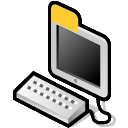-
Editing ANSIMRD.ANS
From Todd Holcomb@3:770/3 to All on Tue Dec 8 16:11:28 2020So when I use the built-in ANSI editor and try to simply edit the color of the header font in the message reader file ansimrd.ans, it completely deletes the display variables (Author, To, Subject, etc) and screws up the spacing of the headers. Is there
a trick to editing this file?
Thanks,
Todd
--- SoupGate-Win32 v1.05
* Origin: Agency HUB, Dunedin - New Zealand | Fido<>Usenet Gateway (3:770/3)
-
From g00r00@1:129/215 to Todd Holcomb on Wed Dec 9 10:34:08 2020
So when I use the built-in ANSI editor and try to simply edit the color
of the header font in the message reader file ansimrd.ans, it completely deletes the display variables (Author, To, Subject, etc) and screws up
the spacing of the headers. Is there a trick to editing this file?
That is the old 1900s ANSI style template which are being removed/replaced with an easier to edit format (albeit very slowly lol)
I would say the easiest way is probably to make the ANSI look like how you want it to look and then edit the .ans file in a text editor and add the ! and & codes using [X and [Y location codes to move the cursor to where you want them displayed. You can see an example of how the default ansimrd.ans at the bottom uses the X/Y codes to set the "read" boundaries where the message text would go if you open it in a text editor.
It sounds like the issue you may be having is because you're doing something like this:
From: &1 To: &2
You have to format those codes because the value of &1 and &2 are not always the same size. So for example
You would want to do something like |$R60<pipe>&3 to format the subject to always be 60 characters in length. IE:
From: |$R30<pipe>&1 To $R30<pipe>&2
I've replaced the | with <pipe> there because Mystic by default will allow you to use those message info codes and pipe color codes while reading messages.
You could also just add [X and [Y to locate the cursor where you want the information and then outpuit &1 etc at the bottom of the ANSI which seems easiest for most people.
--- Mystic BBS v1.12 A47 2020/12/04 (Windows/64)
* Origin: Sector 7 | Mystic WHQ (1:129/215)
-
From Todd Holcomb@3:770/3 to All on Wed Dec 9 19:25:47 2020On Wednesday, December 9, 2020 at 11:20:13 AM UTC-6, g00r00 wrote:
That is the old 1900s ANSI style template which are being removed/replaced with
an easier to edit format (albeit very slowly lol)
I would say the easiest way is probably to make the ANSI look like how you want
it to look and then edit the .ans file in a text editor and add the ! and & codes using [X and [Y location codes to move the cursor to where you want them
displayed. You can see an example of how the default ansimrd.ans at the bottom
uses the X/Y codes to set the "read" boundaries where the message text would go
if you open it in a text editor.
It sounds like the issue you may be having is because you're doing something like this:
From: &1 To: &2
You have to format those codes because the value of &1 and &2 are not always the same size. So for example
You would want to do something like |$R60<pipe>&3 to format the subject to always be 60 characters in length. IE:
From: |$R30<pipe>&1 To $R30<pipe>&2
I've replaced the | with <pipe> there because Mystic by default will allow you
to use those message info codes and pipe color codes while reading messages.
You could also just add [X and [Y to locate the cursor where you want the information and then outpuit &1 etc at the bottom of the ANSI which seems easiest for most people.
Ok, thanks for detailed explanation and the help!
Todd
--- SoupGate-Win32 v1.05
* Origin: Agency HUB, Dunedin - New Zealand | Fido<>Usenet Gateway (3:770/3)
-
From Todd Holcomb@3:770/3 to All on Wed Dec 9 19:45:42 2020What about the !1, !2, etc in those files. Should those be replaced with &1 and &2?
Todd
--- SoupGate-Win32 v1.05
* Origin: Agency HUB, Dunedin - New Zealand | Fido<>Usenet Gateway (3:770/3)
-
From g00r00@1:129/215 to Todd Holcomb on Wed Dec 9 23:38:07 2020
What about the !1, !2, etc in those files. Should those be replaced
with &1 and &2?
In that file the !1 and !2 determine where the "view" of the message text starts and ends (!1 being the first line and !2 being the last line). So what I would recommend doing is just opening the ANS file in a text editor and using those [X and [Y codes to place the !1 and !2. This is what the default ansimrd.ans does and you can open that up in a text editor to use as a reference.
This format is left over from back in the DOS days and back then we used TheDraw which could do that for you. Now its a bigger pain than it was back then, so I have been moving over to using .ini files. I haven't converted the ANSIMRD over to the .ini format yet but I do still plan to. It'll be much easier to work with then.
--- Mystic BBS v1.12 A47 2020/12/04 (Windows/64)
* Origin: Sector 7 | Mystic WHQ (1:129/215)
 Web-based telnet client
Web-based telnet client
Other Links
What is a BBS?
Doors installed on this BBS
Digital Distortion Doors & Tools
Door stats
Trivia scores
Message networks
Terminal software
Emulated games
Synchronet archiver setup
Ready.gov anti-terrorist guidelines as of 2003
Other services
 Telnet
Telnet
 RLogin
RLogin
 IRC
IRC
 Email & news access
Email & news access
Feel free to send me an email.
BBS UPS stats
Who's Online
Recent Visitors
-
DarkRaven
Mon Aug 18 02:28:21 2025
from Arizona via HTTP -
Jamaica Joe
Sun Jul 13 17:39:10 2025
from Las Vegas, NV via HTTP -
Merlin
Mon Apr 14 06:31:48 2025
from Milton, WV via HTTP -
Merlin
Sun Apr 6 09:19:55 2025
from Milton, WV via HTTP
-
DarkRaven
System Info
Sysop: Eric Oulashin Location: Beaverton, Oregon, USA Users: 120 Nodes: 16 (0 / 16) Uptime: 06:19:43 Calls: 7,421 Calls today: 6 Files: 9,254 D/L today: 344 files
(151M bytes)Messages: 385,412